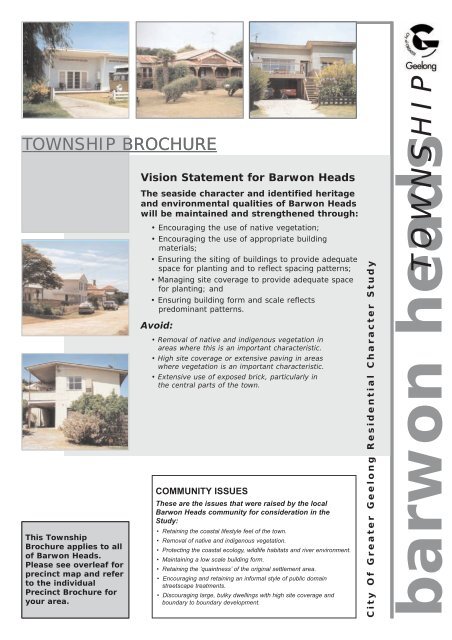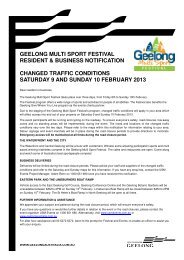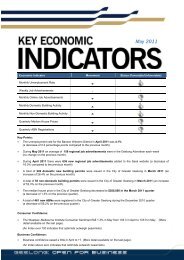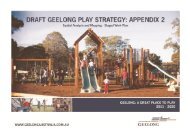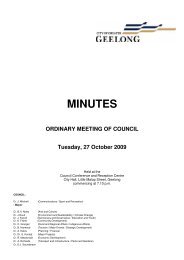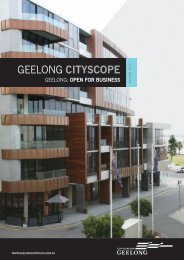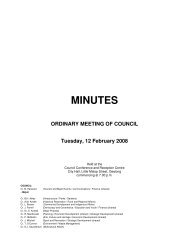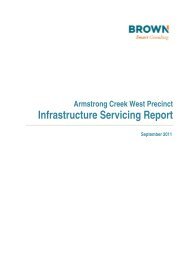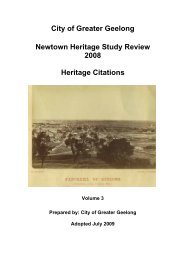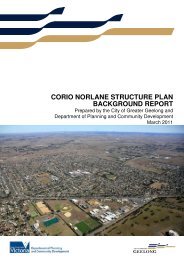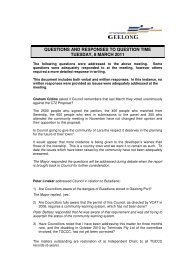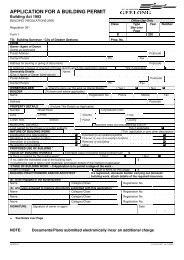Barwon Heads Residential Character Study - City of Greater Geelong
Barwon Heads Residential Character Study - City of Greater Geelong
Barwon Heads Residential Character Study - City of Greater Geelong
Create successful ePaper yourself
Turn your PDF publications into a flip-book with our unique Google optimized e-Paper software.
TOWNSHIP BROCHURE<br />
This Township<br />
Brochure applies to all<br />
<strong>of</strong> <strong>Barwon</strong> <strong>Heads</strong>.<br />
Please see overleaf for<br />
precinct map and refer<br />
to the individual<br />
Precinct Brochure for<br />
your area.<br />
Vision Statement for <strong>Barwon</strong> <strong>Heads</strong><br />
The seaside character and identified heritage<br />
and environmental qualities <strong>of</strong> <strong>Barwon</strong> <strong>Heads</strong><br />
will be maintained and strengthened through:<br />
• Encouraging the use <strong>of</strong> native vegetation;<br />
• Encouraging the use <strong>of</strong> appropriate building<br />
materials;<br />
• Ensuring the siting <strong>of</strong> buildings to provide adequate<br />
space for planting and to reflect spacing patterns;<br />
• Managing site coverage to provide adequate space<br />
for planting; and<br />
• Ensuring building form and scale reflects<br />
predominant patterns.<br />
Avoid:<br />
• Removal <strong>of</strong> native and indigenous vegetation in<br />
areas where this is an important characteristic.<br />
• High site coverage or extensive paving in areas<br />
where vegetation is an important characteristic.<br />
• Extensive use <strong>of</strong> exposed brick, particularly in<br />
the central parts <strong>of</strong> the town.<br />
COMMUNITY ISSUES<br />
These are the issues that were raised by the local<br />
<strong>Barwon</strong> <strong>Heads</strong> community for consideration in the<br />
<strong>Study</strong>:<br />
• Retaining the coastal lifestyle feel <strong>of</strong> the town.<br />
• Removal <strong>of</strong> native and indigenous vegetation.<br />
• Protecting the coastal ecology, wildlife habitats and river environment.<br />
• Maintaining a low scale building form.<br />
• Retaining the ‘quaintness’ <strong>of</strong> the original settlement area.<br />
• Encouraging and retaining an informal style <strong>of</strong> public domain<br />
streetscape treatments.<br />
• Discouraging large, bulky dwellings with high site coverage and<br />
boundary to boundary development.<br />
<strong>City</strong> Of <strong>Greater</strong> <strong>Geelong</strong> <strong>Residential</strong> <strong>Character</strong> <strong>Study</strong><br />
TOWNSHIP<br />
barwon heads
PRECINCT MAP<br />
barwon heads REGION<br />
CITY OF GREATER GEELONG RESIDENTIAL CHARACTER STUDY 2001 ©<br />
and John Curtis Pty Ltd.
1<br />
PRECINCT BROCHURE<br />
<strong>Character</strong> Description<br />
This area is distinctive in <strong>Barwon</strong> <strong>Heads</strong> due to its newer building<br />
styles, which are predominantly brick, and an openness created by its<br />
lack <strong>of</strong> front fencing and low scale building forms. The retained native<br />
coastal vegetation is important to its character and provides a linking<br />
element with the remainder <strong>of</strong> the township.<br />
Key Existing <strong>Character</strong>istics:<br />
Preferred <strong>Character</strong> Statement<br />
• Architectural styles are mainly post 1980s modern villas.<br />
• New and establishing gardens and frequent Tea-tree species.<br />
• Dwellings are predominantly single storey mainly brick.<br />
• Lack <strong>of</strong> front fencing.<br />
The openness <strong>of</strong> the area will be maintained and the seaside character<br />
strengthened by:<br />
• Encouraging low scale dwellings;<br />
• Retaining a lack <strong>of</strong> front fencing; and<br />
• Retaining Tea-tree and encouraging the planting <strong>of</strong> indigenous and native plants.<br />
Avoid:<br />
• Large bulky buildings with high site coverage.<br />
• Removal <strong>of</strong> remnant indigenous species.<br />
This individual Precinct Brochure should be read in<br />
conjunction with the general Township Brochure.<br />
Please see overleaf for Design Guidelines to assist<br />
with the preparation and assessment <strong>of</strong><br />
development proposals.<br />
PRECINCT 1<br />
<strong>City</strong> Of <strong>Greater</strong> <strong>Geelong</strong> <strong>Residential</strong> <strong>Character</strong> <strong>Study</strong><br />
barwon heads
DESIGN GUIDELINES<br />
<strong>Character</strong><br />
Element<br />
Vegetation<br />
Objective<br />
To strengthen the coastal<br />
character <strong>of</strong> the area by planting<br />
<strong>of</strong> appropriate indigenous coastal<br />
species.<br />
Design<br />
Response<br />
1 Retain existing coastal natives and indigenous<br />
trees. (Locate footings outside root zone.)<br />
2 Prepare a landscape plan to accompany all<br />
development proposals that utilises appropriate<br />
coastal species. (see 'Indigenous plants <strong>of</strong> the<br />
<strong>Geelong</strong> region' for information).<br />
PRECINCT 1<br />
barwon heads<br />
Avoid<br />
1 Lack <strong>of</strong> a landscape plan.<br />
2 Planting <strong>of</strong> large exotic<br />
tree species.<br />
Illustration<br />
Siting<br />
To maintain the consistency,<br />
where present, <strong>of</strong> building front<br />
setbacks.<br />
3 The front setback should be not less than the<br />
average setback <strong>of</strong> the adjoining two dwellings.<br />
3 Buildings that are set<br />
further forward than the<br />
closest <strong>of</strong> the buildings on<br />
the adjoining two<br />
properties.<br />
Height and<br />
building form<br />
To encourage innovative<br />
architecture that respects the<br />
coastal township setting.<br />
4 New buildings should be individually designed to<br />
respond to the dominant characteristics <strong>of</strong> the<br />
area, the coastal township setting and the site.<br />
4 Urban period reproduction<br />
styles and detailing.<br />
5 Use skillion, flat or low pitched ro<strong>of</strong> forms.<br />
Front<br />
boundary<br />
treatment<br />
To maintain the openness <strong>of</strong> the<br />
streetscape.<br />
4 Provide no front fencing. 5 Solid front fencing.<br />
CITY OF GREATER GEELONG RESIDENTIAL CHARACTER STUDY 2001 ©<br />
and John Curtis Pty Ltd.
2<br />
PRECINCT BROCHURE<br />
<strong>Character</strong> Description<br />
This Precinct is distinctive in <strong>Barwon</strong> <strong>Heads</strong> due to its bushland<br />
setting and spaciousness created by large lot sizes that enable<br />
buildings to be well separated and setback substantial distances from<br />
the front. In most cases native vegetation has been retained and<br />
buildings are set in an open bushland environment, and sometimes<br />
hidden from the street.<br />
Key Existing <strong>Character</strong>istics:<br />
Preferred <strong>Character</strong> Statement<br />
• Predominant architectural style is single storey post 1980s<br />
large modern villas.<br />
• Gardens include indigenous and native vegetation and high canopy trees.<br />
• Building materials consist <strong>of</strong> brick and timber with mixed ro<strong>of</strong>ing.<br />
• Lack <strong>of</strong> front fences.<br />
• Road is sealed with no kerbing or footpaths.<br />
The spaciousness <strong>of</strong> the area will be maintained and the bush setting<br />
strengthened by:<br />
• Encouraging low scale dwellings that sit within the landscape;<br />
• Encouraging buildings to be setback substantial distances from the front and side boundaries;<br />
• Retaining native and indigenous trees;<br />
• Encouraging the planting <strong>of</strong> native and indigenous vegetation;<br />
• Ensuring low site coverage; and<br />
• Encouraging a lack <strong>of</strong> front fencing and post and wire side fencing.<br />
Avoid:<br />
• Dwellings with high site coverage, including expanses <strong>of</strong> paving.<br />
• Loss <strong>of</strong> native vegetation.<br />
• Solid or high fences.<br />
This individual Precinct Brochure should be read in<br />
conjunction with the general Township Brochure.<br />
Please see overleaf for Design Guidelines to assist<br />
with the preparation and assessment <strong>of</strong><br />
development proposals.<br />
PRECINCT 2<br />
<strong>City</strong> Of <strong>Greater</strong> <strong>Geelong</strong> <strong>Residential</strong> <strong>Character</strong> <strong>Study</strong><br />
barwon heads
DESIGN GUIDELINES barwon heads PRECINCT 2<br />
<strong>Character</strong><br />
Element<br />
Objective<br />
Design<br />
Response<br />
Avoid<br />
Illustration<br />
Vegetation<br />
To maintain and strengthen the<br />
native and indigenous vegetation<br />
dominated streetscapes.<br />
1 Retain existing high canopy trees and<br />
understorey wherever possible. (Locate footings<br />
outside root zone.)<br />
1 Removal <strong>of</strong> high canopy<br />
native and indigenous<br />
trees.<br />
2 Replace any trees lost due to development with<br />
similar size indigenous or native trees.<br />
3 One substantial indigenous or native tree should<br />
be planted for every 150 sq.m. <strong>of</strong> site area.<br />
2 Dwellings that do not<br />
provide sufficient<br />
setbacks from all<br />
boundaries to<br />
accommodate trees /<br />
or screening plants.<br />
Siting<br />
To minimise the visibility <strong>of</strong><br />
buildings from the road.<br />
4 Locate buildings well back from the road and<br />
within the landform and vegetation so as to be<br />
wholly or partly obscured from view.<br />
3 Buildings that are wholly<br />
visible from the road.<br />
Site<br />
coverage<br />
To ensure that adequate space is<br />
available on private land for the<br />
retention and planting <strong>of</strong><br />
vegetation.<br />
5 The total hard surface site coverage (including<br />
outbuildings, swimming pools, tennis courts,<br />
driveways and all non-permeable surfaces),<br />
should not exceed 55%.<br />
4 Buildings that exceed the<br />
site coverage specified by<br />
more than 5%.<br />
6 Proposals that exceed the specified site coverage<br />
maximums must demonstrate that the Site<br />
Coverage objective and all remaining Objectives<br />
and Design responses have been met.<br />
Height and<br />
building form<br />
To ensure that buildings and<br />
extensions do not dominate the<br />
streetscape and wider landscape<br />
setting.<br />
7 Buildings should not protrude above the<br />
predominant tree canopy height.<br />
5 Buildings that protrude<br />
above that tree canopy<br />
height.<br />
Front<br />
boundary<br />
treatment<br />
To maintain and enhance the<br />
continuous flow <strong>of</strong> vegetation<br />
across the landscape.<br />
8 Provide no front fencing, or post and wire<br />
fencing to the front and side boundaries.<br />
6 Solid front, side and rear<br />
fencing.<br />
CITY OF GREATER GEELONG RESIDENTIAL CHARACTER STUDY 2001 ©<br />
and John Curtis Pty Ltd.
3<br />
PRECINCT BROCHURE<br />
<strong>Character</strong> Description<br />
This Precinct is distinctive due to its strong seaside township<br />
character created by the low scale architectural styles and mixture <strong>of</strong><br />
building materials. The buildings frequently have low pitched or flat<br />
ro<strong>of</strong>s which adds to their low scale nature and the frequent lack <strong>of</strong><br />
front fencing, or low open style fencing adds to an open streetscape.<br />
The buildings are set within established gardens frequently with<br />
retained native vegetation. The seaside feel <strong>of</strong> the area could be<br />
strengthened by encouraging the planting <strong>of</strong> indigenous species.<br />
Key Existing <strong>Character</strong>istics:<br />
Preferred <strong>Character</strong> Statement<br />
• Gardens are generally established with a mix <strong>of</strong> natives and exotic plants.<br />
• Dwellings are single storey and building materials consist <strong>of</strong><br />
brick/timber/fibro and mixed ro<strong>of</strong>ing.<br />
• Setbacks are standard, and consistent.<br />
• Architecture is 50s-70s seaside style.<br />
• Front fences are either not present or low, usually open style.<br />
Maintain and strengthen the seaside township character and openness<br />
<strong>of</strong> the area by:<br />
• Encouraging low scale dwellings;<br />
• Ensuring dwellings are set back from the front in accordance with the predominant setback in the<br />
street, and are <strong>of</strong>f-set from at least one side boundary;<br />
• Encouraging the retention <strong>of</strong> established native and indigenous trees;<br />
• Encouraging the use <strong>of</strong> lighter looking building materials, including timber and other non-masonry<br />
cladding; and<br />
• Encouraging a lack <strong>of</strong> front fencing or low, open style.<br />
Avoid:<br />
• Large, bulky buildings with high site coverage.<br />
• A predominance <strong>of</strong> exposed brick buildings.<br />
• High front fences.<br />
This individual Precinct Brochure should be read in<br />
conjunction with the general Township Brochure.<br />
Please see overleaf for Design Guidelines to assist<br />
with the preparation and assessment <strong>of</strong><br />
development proposals.<br />
PRECINCT 3<br />
<strong>City</strong> Of <strong>Greater</strong> <strong>Geelong</strong> <strong>Residential</strong> <strong>Character</strong> <strong>Study</strong><br />
barwon heads
DESIGN GUIDELINES barwon heads PRECINCT 3<br />
<strong>Character</strong><br />
Element<br />
Objective<br />
Design<br />
Response<br />
Avoid<br />
Illustration<br />
Vegetation<br />
To maintain and strengthen the<br />
coastal character <strong>of</strong> the<br />
vegetation.<br />
1 Retain existing native and indigenous species<br />
wherever possible. (Locate footings outside root<br />
zone.)<br />
1 Removal <strong>of</strong> established<br />
native and indigenous<br />
species.<br />
2 Replace any trees lost due to development with<br />
similar size appropriate coastal species.<br />
2 Planting <strong>of</strong> large exotic<br />
tree species.<br />
Prepare a landscape plan to accompany all<br />
development proposals that utilises appropriate<br />
coastal species.<br />
Siting<br />
To reflect the existing rhythm <strong>of</strong><br />
dwelling spacing.<br />
3 Buildings should be <strong>of</strong>fset from at least one side<br />
boundary.<br />
3 Boundary to boundary<br />
development.<br />
To maintain the consistency,<br />
where present, <strong>of</strong> building front<br />
setbacks.<br />
4 The front setback should be not less than the<br />
average setback <strong>of</strong> the adjoining two dwellings.<br />
4 Buildings that are set<br />
further forward than the<br />
closest <strong>of</strong> the buildings on<br />
the two adjoining<br />
properties.<br />
Height and<br />
building form<br />
To ensure that new buildings and<br />
extensions do not dominate the<br />
streetscape.<br />
5 Respect the predominant building height in the<br />
street and nearby properties. The height at the<br />
front should match the typical single storey wall<br />
height.<br />
6 Use skillion, flat, single pitch or low pitched ro<strong>of</strong><br />
forms.<br />
5 Buildings that exceed by<br />
more than one storey the<br />
predominant building<br />
height in the street and<br />
nearby properties.<br />
6 High pitched ro<strong>of</strong> forms.<br />
Materials and<br />
design detail<br />
To use lighter looking building<br />
materials and finishes that<br />
complement the dominant<br />
pattern within the streetscape<br />
and coastal setting.<br />
7 Use timber or other non-masonry sheeting or<br />
cladding materials where possible.<br />
8 Render, bag or paint masonry surfaces.<br />
7 Exposed red or orange<br />
brick.<br />
8 Urban period reproduction<br />
styles and detailing.<br />
Front<br />
boundary<br />
treatment<br />
To maintain and enhance the<br />
continuous flow <strong>of</strong> the garden<br />
settings and the openness <strong>of</strong> the<br />
streetscape.<br />
9 Provide no front fencing. 9 High, solid front fencing.<br />
CITY OF GREATER GEELONG RESIDENTIAL CHARACTER STUDY 2001 ©<br />
and John Curtis Pty Ltd.
4<br />
PRECINCT BROCHURE<br />
<strong>Character</strong> Description<br />
The Precinct is distinctive due to its seaside township character<br />
derived from the remaining pre and interwar buildings, and the<br />
mixture <strong>of</strong> post war and recent styles with a variety <strong>of</strong> building<br />
materials. The generally low scale buildings are set within mature<br />
native and exotic gardens complemented by mature street trees and<br />
informal roadway treatments. The character <strong>of</strong> the area could be<br />
strengthened by encouraging a lack <strong>of</strong> front fencing, or open style<br />
front fences and further native planting.<br />
Key Existing <strong>Character</strong>istics:<br />
• Vegetation is mostly indigenous/native Tea-tree.<br />
• Architecture is 50s-60s seaside style, with Victorian and Edwardian<br />
buildings along the river foreshore.<br />
• Dwellings are single storey with the exception <strong>of</strong> dwellings on the<br />
southern edge <strong>of</strong> the precinct that are predominantly double storey.<br />
• Buildings are generally set back 6-7m from front fence, and 1-3m from<br />
the side boundaries.<br />
• Building materials are mixed brick, timber and fibro with mixed ro<strong>of</strong>ing.<br />
• Part <strong>of</strong> the precinct has unsealed roads, all roads are unkerbed.<br />
• Front fencing varies from no front fence to average height open style.<br />
Preferred <strong>Character</strong> Statement<br />
The seaside township character <strong>of</strong> the area will be maintained and<br />
strengthened by:<br />
• Retaining the identified heritage buildings and ensuring adjacent dwellings respect the form, scale<br />
and materials <strong>of</strong> these buildings;<br />
• Encouraging the use <strong>of</strong> lighter looking building materials, including timber and other non-masonry<br />
cladding;<br />
• Encouraging low scale dwelling types;<br />
• Encouraging the retention and planting <strong>of</strong> indigenous and native trees;<br />
• Encouraging the use <strong>of</strong> lighter looking building materials, including timber and other non-masonry<br />
cladding;<br />
• Encouraging low scale dwelling types; and<br />
• Encouraging the retention and planting <strong>of</strong> indigenous and native trees.ng <strong>of</strong> indigenous and<br />
native plants.<br />
Avoid:<br />
• Removal <strong>of</strong> Moonah and Tea-tree in the public and private domain.<br />
• Sealing and kerbing <strong>of</strong> roads.<br />
• Large bulky buildings or buildings with high site coverage, that dominate the streetscape.<br />
• A predominance <strong>of</strong> exposed brick buildings.<br />
• High front fences.<br />
This individual Precinct Brochure should be read in<br />
conjunction with the general Township Brochure.<br />
Please see overleaf for Design Guidelines to assist<br />
with the preparation and assessment <strong>of</strong><br />
development proposals.<br />
PRECINCT 4<br />
<strong>City</strong> Of <strong>Greater</strong> <strong>Geelong</strong> <strong>Residential</strong> <strong>Character</strong> <strong>Study</strong><br />
barwon heads
DESIGN GUIDELINES barwon heads PRECINCT 4<br />
<strong>Character</strong><br />
Element<br />
Objective<br />
Design<br />
Response<br />
Avoid<br />
Illustration<br />
Vegetation<br />
To retain buildings that contribute to<br />
the valued character <strong>of</strong> the area.<br />
1 Retain, whenver possible, intact Victorian,<br />
Edwardian, Federation and Californian Bungalow<br />
era dwellings.<br />
1 Demolition <strong>of</strong> intact and good<br />
condition dwellings from these<br />
eras.<br />
Vegetation<br />
To strengthen the coastal<br />
character <strong>of</strong> the area by planting<br />
<strong>of</strong> appropriate indigenous coastal<br />
species.<br />
2 Retain existing coastal native and indigenous<br />
trees and understorey whenever possible.<br />
(Locate footings outside root zone.)<br />
3 Prepare a landscape plan to accompany all<br />
development proposals that utilises appropriate<br />
coastal species. (see ‘Indigenous plants <strong>of</strong> the<br />
<strong>Geelong</strong> region’ for information.)<br />
2 Lack <strong>of</strong> a landscape plan.<br />
3 Planting <strong>of</strong> large exotic<br />
tree species.<br />
4 Removal <strong>of</strong> high canopy<br />
native and indigenous<br />
trees.<br />
Topography/<br />
landform<br />
To minimise site disturbance and<br />
impact <strong>of</strong> the building on the<br />
landscape.<br />
4 Buildings should be designed to follow the<br />
contours <strong>of</strong> the site or step down the site.<br />
5 Major excavation works<br />
to accommodate<br />
dwellings or<br />
appurtenances.<br />
Siting<br />
To reflect the existing rhythm <strong>of</strong><br />
dwelling spacing<br />
5 Buildings should be setback at least 2 metres<br />
from one side boundary.<br />
6 Boundary to boundary<br />
development.<br />
To maintain consistency, where<br />
present, <strong>of</strong> building front<br />
setbacks<br />
6 The front setback should be not less than the<br />
average setback <strong>of</strong> the adjoining two dwellings.<br />
7 Buildings that are set<br />
further forward than the<br />
closest <strong>of</strong> the buildings on<br />
the two adjoining<br />
properties.<br />
Site<br />
coverage<br />
To ensure that adequate space is<br />
available on private land for the<br />
retention and planting <strong>of</strong><br />
vegetation.<br />
7 The total hard surface site coverage (including<br />
all buildings, swimming pools, tennis courts,<br />
driveways and all non-permeable surfaces),<br />
should not exceed 50%.<br />
8 Buildings that exceed the<br />
site coverage specified by<br />
more than 5%.<br />
8 Proposals that exceed the specified site coverage<br />
maximums must demonstrate that the Site<br />
Coverage objective and all remaining Objectives<br />
and Design responses have been met.<br />
Height and<br />
building form<br />
To ensure that buildings and<br />
extensions do not dominate the<br />
streetscape and wider landscape<br />
setting.<br />
9 Buildings should not protrude above the<br />
predominant tree canopy height.<br />
9 Buildings that protrude<br />
above the tree canopy<br />
height.<br />
Materials and<br />
design detail<br />
To use lighter looking building<br />
materials and finishes that<br />
complement the dominant<br />
pattern within the streetscape<br />
and the coastal setting.<br />
10 Use timber or other non-masonry sheeting or<br />
cladding materials where possible.<br />
11 Render, bag or paint masonry surfaces.<br />
10 Exposed red or orange<br />
brick.<br />
11 Urban period reproduction<br />
styles - and detailing.<br />
Front<br />
boundary<br />
treatment<br />
To maintain and enhance the<br />
openness <strong>of</strong> the streetscape.<br />
12 Provide no front fencing or open style front<br />
fencing up to a maximum <strong>of</strong> 1.2 metres.<br />
13 Front fences should not exceed 1.2 metres<br />
other than in exceptional circumstances.<br />
12 Solid front fencing.<br />
Waterfront<br />
development<br />
To recognise the desire to<br />
maximise views along the<br />
waterfront, while ensuring that<br />
new buildings and extensions<br />
respect the patterns <strong>of</strong><br />
development and the coastal<br />
setting and character <strong>of</strong> the<br />
area.<br />
14 Buildings should not exceed 7m in height, other<br />
than for the ro<strong>of</strong> structure.<br />
15 Buildings exceeding the specified height must<br />
demonstrate that the development will not<br />
dominate the streetscape or long views <strong>of</strong> the<br />
area, and complies with all other Objectives and<br />
Design responses.<br />
16 Incorporate building elements and details that<br />
contribute to a lightness <strong>of</strong> structure including<br />
balconies, verandahs, light-transparent<br />
ballustrading and gable ends.<br />
13 Buildings that exceed the<br />
specified height by more<br />
than 0.5 metres.<br />
14 Large, bulky buildings<br />
with unarticulated front<br />
and side wall surfaces.<br />
CITY OF GREATER GEELONG RESIDENTIAL CHARACTER STUDY 2001 ©<br />
and John Curtis Pty Ltd.
5<br />
PRECINCT BROCHURE<br />
<strong>Character</strong> Description<br />
The Precinct is distinctive due to its isolation and spaciousness, due<br />
partly to its location between the golf course and the coast, and the<br />
appearance <strong>of</strong> buildings sited within and rising from the coastal scrub.<br />
The buildings are eclectic in style, and include older styles, however<br />
muted tones that blend with the scrub are preferable. Maintenance <strong>of</strong><br />
the density <strong>of</strong> the vegetation is important to the area’s character and<br />
buildings should be sited to minimise the extent <strong>of</strong> the buildings are<br />
visible from the roadway.<br />
Key Existing <strong>Character</strong>istics:<br />
Preferred <strong>Character</strong> Statement<br />
• Indigenous Tea-tree species dominate the vegetation.<br />
• All dwellings are constructed <strong>of</strong> timber or render with iron ro<strong>of</strong>s and are<br />
usually two storeys in height.<br />
• Architecture is characterised by post 1980’s grand seaside style.<br />
• The eastern half <strong>of</strong> this precinct has high front fences, while the western<br />
half has no front fences.<br />
• The road is unsealed.<br />
The spacious setting within coastal vegetation and the heritage<br />
qualities <strong>of</strong> the area will be retained and enhanced by:<br />
• Development that respects the 1-2 storey scale <strong>of</strong> development in the area;<br />
• Ensuring development is <strong>of</strong>f-set from all boundaries;<br />
• Minimising the visibility <strong>of</strong> development from the street;<br />
• Minimising the amount <strong>of</strong> hard paving around the dwelling;<br />
• Encouraging innovative architecture that reflects the coastal setting;<br />
• Requiring the use <strong>of</strong> lighter looking materials that blend in colour with the vegetation <strong>of</strong><br />
the area;<br />
• Retaining and planting indigenous and native vegetation including Moonah and appropriate<br />
coastal Tea-tree species; and<br />
• Encouraging no or post and wire fencing.<br />
Avoid:<br />
• Removal <strong>of</strong> native vegetation and planting <strong>of</strong> exotic species.<br />
• Development with high site coverage or extensive paving.<br />
• Large, exposed brick buildings.<br />
• High or solid front fences.<br />
This individual Precinct Brochure should be read in<br />
conjunction with the general Township Brochure.<br />
Please see overleaf for Design Guidelines to assist<br />
with the preparation and assessment <strong>of</strong><br />
development proposals.<br />
PRECINCT 5<br />
<strong>City</strong> Of <strong>Greater</strong> <strong>Geelong</strong> <strong>Residential</strong> <strong>Character</strong> <strong>Study</strong><br />
barwon heads
DESIGN GUIDELINES barwon heads PRECINCT 5<br />
<strong>Character</strong><br />
Element<br />
Objective<br />
Design<br />
Response<br />
Avoid<br />
Illustration<br />
Vegetation<br />
To maintain and strengthen the<br />
coastal vegetation dominated<br />
streetscapes.<br />
1 Retain existing native and indigenous species<br />
wherever possible. (Locate footings outside root<br />
zone.)<br />
2 Replace any trees lost due to development with<br />
similar size appropriate coastal species.<br />
3 Prepare a landscape plan to accompany all<br />
development proposals that utilises appropriate<br />
coastal species. (see 'Indigenous plants <strong>of</strong> the<br />
<strong>Geelong</strong> region' for information).<br />
1 Removal <strong>of</strong> established<br />
indigenous species.<br />
2 Lack <strong>of</strong> a landscape plan.<br />
3 Planting <strong>of</strong> exotic tree<br />
species.<br />
Siting<br />
To minimise the visibility <strong>of</strong><br />
buildings from the road.<br />
4 Locate buildings well back from the road and<br />
within the landform and vegetation so as to be<br />
at least partly obscured from view.<br />
4 Buildings that are wholly<br />
visible from the road.<br />
Topography/<br />
landform<br />
To minimise site disturbance and<br />
impact <strong>of</strong> the building on the<br />
landscape.<br />
5 Buildings should be designed to follow the<br />
contours <strong>of</strong> the site or step down the site.<br />
5 Major excavation works<br />
to accommodate<br />
dwellings or<br />
appurtenances.<br />
Site<br />
coverage<br />
To ensure that adequate space is<br />
available on private land for the<br />
retention and planting <strong>of</strong><br />
vegetation.<br />
6 The total building site coverage should not<br />
exceed 20%.<br />
7 The total hard surface site coverage (including<br />
outbuildings, swimming pools, tennis courts,<br />
driveways and all non-permeable surfaces),<br />
should not exceed 40%.<br />
6 Total hard site coverage<br />
that exceeds the specified<br />
site coverage by more<br />
than 5%.<br />
Height and<br />
building form<br />
To ensure that buildings and<br />
extensions do not dominate the<br />
streetscape and wider landscape<br />
setting.<br />
8 Buildings should not exceed 7.5 metres in<br />
height.<br />
9 Buildings exceeding the specified height must be<br />
demonstrate that the development will not<br />
dominate the streetscape or long views <strong>of</strong> the<br />
area, and complies with all other Objectives and<br />
Design responses.<br />
7 Buildings that exceed the<br />
specified height by more<br />
than 0.5 metres.<br />
To encourage innovative<br />
architecture that respects the<br />
coastal setting.<br />
10 New buildings should be individually designed to<br />
respond to the dominant characteristics <strong>of</strong> the<br />
area and the site.<br />
8 Large, bulky buildings<br />
with unarticulated front<br />
and side wall surfaces.<br />
11 Incorporate building elements and details that<br />
contribute to a lightness <strong>of</strong> structure including<br />
balconies, verandahs, light transparent<br />
ballustrading and gable ends.<br />
Materials and<br />
design detail<br />
To use lighter looking building<br />
materials and finishes that<br />
complement the vegetation and<br />
coastal setting.<br />
12 Use earthy toned building materials, finishes or<br />
paint colours.<br />
13 Use timber or other non-masonry sheeting or<br />
cladding materials where possible.<br />
9 Exposed red or orange<br />
brick.<br />
10 Urban period<br />
reproduction styles and<br />
detailing.<br />
Front<br />
boundary<br />
treatment<br />
To maintain and enhance the<br />
continuous flow <strong>of</strong> vegetation<br />
across the landscape.<br />
14 Provide no front fencing, and post and wire side<br />
and rear fences.<br />
11 Solid front, side or rear<br />
fencing<br />
CITY OF GREATER GEELONG RESIDENTIAL CHARACTER STUDY 2001 ©<br />
and John Curtis Pty Ltd.
6<br />
PRECINCT BROCHURE<br />
<strong>Character</strong> Description<br />
This Precinct is distinctive due to its mixture <strong>of</strong> architectural styles<br />
and building materials, and its river-edge location, which encourages<br />
higher development. Development in this Precinct is therefore highly<br />
visible, particularly from the eastern entrance and vistas to the<br />
township. Vegetation cover varies from low level to more substantial<br />
gardens with trees including a predominance <strong>of</strong> natives and frequent<br />
Tea-tree.<br />
Key Existing <strong>Character</strong>istics:<br />
Preferred <strong>Character</strong> Statement<br />
• Gardens are established with a dominance <strong>of</strong> native trees and occasional<br />
exotic.<br />
• Architectural styles include Late Victorian, Edwardian, inter-war, 50s-70s<br />
seaside, 60s-80s and post 1980s modern villas.<br />
• The development is frequently double storey.<br />
• Front setbacks vary, and side setbacks are usually provided from at least<br />
one boundary.<br />
• The south-eastern section <strong>of</strong> the precinct uses timber and iron ro<strong>of</strong><br />
building materials, while the remainder utilises a mixture <strong>of</strong> brick,<br />
timber and fibro with mixed ro<strong>of</strong>s.<br />
• The narrower, northern section <strong>of</strong> the precinct is characterised<br />
by high front fencing. Low or open styles <strong>of</strong> front fence predominate in<br />
the remainder <strong>of</strong> the area.<br />
The area’s seaside character will be strengthened and the cohesion <strong>of</strong><br />
the area enhanced by:<br />
• Encouraging development that respects the general 1-2 storey scale <strong>of</strong> development in the area;<br />
• Ensuring development is <strong>of</strong>f-set from at least one boundary;<br />
• Encouraging the use <strong>of</strong> lighter looking materials;<br />
• Encouraging the retention and planting <strong>of</strong> native vegetation; and<br />
• Discouraging high front fences.<br />
Avoid:<br />
• Removal <strong>of</strong> existing native vegetation.<br />
• Large, bulky buildings that are built boundary to boundary.<br />
• A predominance <strong>of</strong> exposed brick buildings.<br />
This individual Precinct Brochure should be read in<br />
conjunction with the general Township Brochure.<br />
Please see overleaf for Design Guidelines to assist<br />
with the preparation and assessment <strong>of</strong><br />
development proposals.<br />
PRECINCT 6<br />
<strong>City</strong> Of <strong>Greater</strong> <strong>Geelong</strong> <strong>Residential</strong> <strong>Character</strong> <strong>Study</strong><br />
barwon heads
DESIGN GUIDELINES barwon heads PRECINCT 6<br />
<strong>Character</strong><br />
Element<br />
Objective<br />
Design<br />
Response<br />
Avoid<br />
Illustration<br />
Vegetation<br />
To maintain a balance between<br />
ro<strong>of</strong> tops and tree canopy when<br />
the area is viewed from a<br />
distance.<br />
1 Buildings should be sited and designed to<br />
incorporate space for the planting <strong>of</strong> substantial<br />
vegetation.<br />
2 Retain existing high canopy trees and<br />
understorey wherever possible.<br />
3 Replace any trees lost due to development with<br />
similar size indigenous or native trees.<br />
1 Removal <strong>of</strong> high canopy<br />
native and indigenous<br />
trees.<br />
2 Dwellings that do not<br />
provide sufficient<br />
setbacks from at least<br />
two boundaries to<br />
accommodate trees.<br />
Siting<br />
To provide for reasonable sharing<br />
<strong>of</strong> views to the ocean, river or<br />
coast.<br />
4 Buildings should be sited taking into account the<br />
view corridors to the ocean, river or coast from<br />
nearby properties.<br />
3 Buildings that completely<br />
obscure views from public<br />
areas.<br />
To reflect the existing rhythm <strong>of</strong><br />
dwelling spacing.<br />
5 Building should be setback from at least one<br />
boundary.<br />
4 Boundary to boundary<br />
development.<br />
Site<br />
coverage<br />
To ensure that adequate space is<br />
available on private land for the<br />
retention and planting <strong>of</strong><br />
vegetation.<br />
6 The total hard surface site coverage (including<br />
outbuildings, swimming pools, tennis courts,<br />
driveways and all non-permeable surfaces),<br />
should not exceed 55%.<br />
5 Buildings that exceed the site<br />
coverage specified by more<br />
than 5%.<br />
7 Buildings exceeding the specified site coverage<br />
must be demonstrate that the Site coverage<br />
Objective and all other Objectives and Design<br />
responses have been met.<br />
Height and<br />
building form<br />
To ensure that buildings and<br />
extensions do not dominate the<br />
streetscape and longer views <strong>of</strong><br />
the area.<br />
8 Buildings should not exceed 7.5 metres in<br />
height.<br />
9 Buildings that exceed the specified height must<br />
demonstrate compliance with the Height<br />
Objective and all other Objectives and Design<br />
responses.<br />
6 Buildings that exceed that<br />
specified height by more<br />
than 0.5 metres.<br />
To encourage innovative<br />
architecture that respects the<br />
coastal setting.<br />
10 New buildings should be individually designed to<br />
respond to the dominant characteristics <strong>of</strong> the<br />
area and the site.<br />
7 Large, bulky buildings<br />
with unarticulated front<br />
and side wall surfaces.<br />
11 Incorporate building elements and details that<br />
contribute to a lightness <strong>of</strong> structure including<br />
balconies, verandahs, light transparent<br />
ballustrading and gable ends.<br />
Materials and<br />
design detail<br />
To use lighter looking building<br />
materials and finishes that<br />
complement the dominant<br />
pattern within the streetscape /<br />
coastal setting.<br />
12 Use timber or other non-masonry sheeting or<br />
cladding materials where possible.<br />
13 Render, bag or paint masonry surfaces.<br />
8 Exposed red or orange<br />
brick.<br />
9 Urban period reproduction<br />
styles and detailing.<br />
Front<br />
boundary<br />
treatment<br />
To maintain the openness <strong>of</strong> the<br />
streetscape.<br />
14 Provide no front fencing or open-style front<br />
fencing to a maximum <strong>of</strong> 1.2 metres.<br />
10 High, solid front<br />
fencing.<br />
CITY OF GREATER GEELONG RESIDENTIAL CHARACTER STUDY 2001 ©<br />
and John Curtis Pty Ltd.
7<br />
PRECINCT BROCHURE<br />
<strong>Character</strong> Description<br />
The Precinct is distinctive due to its bush garden court character,<br />
created by the frequent lack <strong>of</strong> front fencing, the regular front and<br />
side setbacks and established native gardens. The seaside location<br />
<strong>of</strong> the area is not always evident other than through the use <strong>of</strong> typical<br />
coastal vegetation such as Tea-tree and the mix <strong>of</strong> building materials.<br />
Key Existing <strong>Character</strong>istics:<br />
Preferred <strong>Character</strong> Statement<br />
• Vegetation is established and characterised by Tea-tree in<br />
the north-eastern corner.<br />
• Front setbacks are generally standard and consistent. Side setbacks are<br />
usually provided from at least one boundary.<br />
• A range <strong>of</strong> building materials are utilised.<br />
• The architectural style is 60s–80s, with occasional earlier dwellings.<br />
• Dwellings are single storey.<br />
• Many dwellings have no front fences.<br />
The bush garden court character <strong>of</strong> the area will be retained and the<br />
seaside location enhanced by:<br />
• Encouraging development that respects the low scale <strong>of</strong> development in the area;<br />
• Ensuring development is set back from the front in accordance with the predominant setback in<br />
the street and is <strong>of</strong>f-set from at least one boundary;<br />
• Encouraging the incorporation <strong>of</strong> lighter looking materials where possible;<br />
• Encouraging the retention and planting <strong>of</strong> native vegetation; and<br />
• Discouraging front fences.<br />
Avoid:<br />
• Large, bulky buildings with boundary to boundary development.<br />
• High or solid front front fences.<br />
This individual Precinct Brochure should be read in<br />
conjunction with the general Township Brochure.<br />
Please see overleaf for Design Guidelines to assist<br />
with the preparation and assessment <strong>of</strong><br />
development proposals.<br />
PRECINCT 7<br />
<strong>City</strong> Of <strong>Greater</strong> <strong>Geelong</strong> <strong>Residential</strong> <strong>Character</strong> <strong>Study</strong><br />
barwon heads
DESIGN GUIDELINES barwon heads PRECINCT 7<br />
<strong>Character</strong><br />
Element<br />
Objective<br />
Design<br />
Response<br />
Avoid<br />
Illustration<br />
Vegetation<br />
To maintain and strengthen the<br />
coastal vegetation dominated<br />
streetscapes.<br />
1 Retain established, indigenous coastal tree and<br />
understorey species. (Locate footings outside<br />
root zone.)<br />
2 Replace any indigenous trees lost due to the<br />
development with similar species and size trees.<br />
3 Prepare a landscape plan to accompany all<br />
development proposals that utilises appropriate<br />
coastal species. (see 'Indigenous plants <strong>of</strong> the<br />
<strong>Geelong</strong> region' for information).<br />
1 Removal <strong>of</strong> established,<br />
indigenous species.<br />
2 Planting <strong>of</strong> large exotic<br />
tree species.<br />
3 Lack <strong>of</strong> a landscape plan.<br />
Siting<br />
To reflect the existing rhythm <strong>of</strong><br />
dwelling spacing.<br />
4 Buildings should be setback at least 2 metres<br />
from one side boundary.<br />
4 Boundary to boundary<br />
development.<br />
To maintain the consistency,<br />
where present, <strong>of</strong> building front<br />
setbacks.<br />
5 The front setback should be not less than the<br />
average setback <strong>of</strong> the adjoining two<br />
dwellings.<br />
5 Buildings that are set<br />
further forward than the<br />
closest <strong>of</strong> the buildings on<br />
the two adjoining<br />
properties.<br />
Height and<br />
building form<br />
To ensure that new buildings and<br />
extensions do not dominate the<br />
streetscape.<br />
6 Respect the predominant building height in the<br />
street and nearby properties. The height at the<br />
front <strong>of</strong> the dwelling should match the typical<br />
single storey wall height.<br />
6 Buildings that exceed by<br />
more than one storey the<br />
predominant building<br />
height in the street and<br />
nearby properties.<br />
Materials and<br />
design detail<br />
To use lighter looking building<br />
materials and finishes that<br />
complement the dominant<br />
pattern within the streetscape<br />
and coastal setting.<br />
7 Use timber or other non-masonry sheeting or<br />
cladding materials where possible.<br />
8 Render, bag or paint masonry surfaces.<br />
7 Exposed red or orange<br />
brick.<br />
8 Urban period reproduction<br />
styles and detailing.<br />
Front<br />
boundary<br />
treatment<br />
To maintain and enhance the<br />
continuous flow <strong>of</strong> the garden<br />
settings and the openness <strong>of</strong> the<br />
streetscape.<br />
9 Provide no fencing. 9 High or solid front<br />
fencing.<br />
CITY OF GREATER GEELONG RESIDENTIAL CHARACTER STUDY 2001 ©<br />
and John Curtis Pty Ltd.


